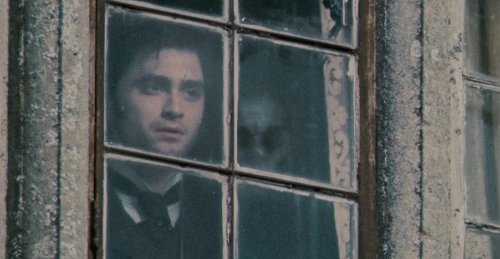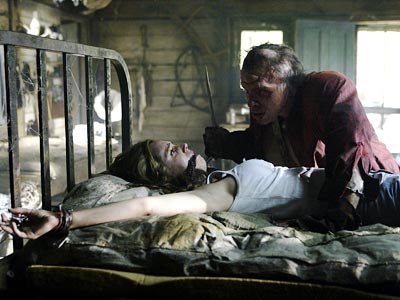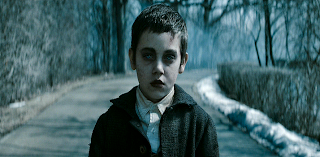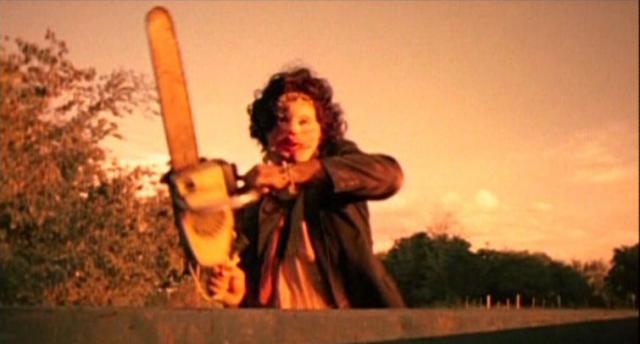Horror films are
unsettling films designed to frighten and panic,
and to invoke our hidden worst fears, often in a terrifying, shocking
finale, while captivating and entertaining us at the same time in a
cathartic experience. They
deal with our most primal nature and its fears: our nightmares, our
vulnerability, our alienation, our revulsions, our terror of the
unknown, our fear of death and dismemberment, loss of identity, or fear
of sexuality. Film
genres have different codes and conventions that separate them from one
another. This allows the target audience to identify immediately which
genre is presented in a specific media text, whether it is moving or
still images. Similar things crop up again and again in horror films
setting these codes and conventions. Some, however, challenge them to
create originality, freshness and uniqueness making them in some ways,
unpredictable. Nonetheless, you cannot challenge them to the point where
the codes and conventions are lost and the media text’s genre isn’t
recognisable. Different aspects of media texts are made to set the
horror genre. These include: settings, characters, costume, sound,
events and occurrences, sights, lighting, weapons, camera shots and
angles.
Settings
Settings
are very important in the horror genre as it can say a lot about it. It
sets the scene, giving of a certain mood and atmosphere which allow the
audience to identify the genre. Common settings in the genre of horror
include uses of large, spacious environments; this gives the characters,
who are feeling adventurous, the space needed to explore the area and
means they have more spaced to hide.
Horrors
are also often set in suburban areas, for example, a common location is
in a characters home, which is especially common in supernatural and
psychological horrors. Common
settings in Horror movies include uses of large, vast, spacious
environments; this gives characters more area’s to explore in the
‘middle of nowhere’ and means they have more spaces to hide. Horrors are
often set in suburban areas, for example, a common location is in a
characters home (especially in supernatural horrors), and this achieves
common ground between the character and the audience which adds to the
scare-factor. Also, with more modern horrors, the houses in which the
film is set contain more cosy and homily vibes but still maintain an
eerie, austere presence. The houses in which the films are set contain a warm hospitable vibe
but still maintain an eerie presence; having a normal looking home makes
the target audience more uncomfortable in theirs, making the horror
film successful in frightening and scaring the target audience. The way
in which horror films make these settings, which are known to be safe,
scary, is by using appropriate lighting and contrapuntal sound to
provide a spooky and unsettling atmosphere.

Camp Crystal Lake - Friday 13th

House featured in the Amityville Horror
Other
settings include churches (huge relation to supernatural and Christ and
this is the main base for the supernatural genre); barns and farms as
they are deserted, dark and old; fields and country roads as they too
are deserted, and associated with creepy looking surrounds e.g. trees,
animals etc.
Characters
At
the centre of the horror genre, you have this battle between either
good and evil, or innocent and evil and this has a big influence on the
characters we meet. All horrors, regardless of subgenre there is some
sort of antagonist.
Antagonist
In supernatural they are either
viscous ghosts/spirits or demons determined to get revenge, create
terror or communicate and try to send a message to the character they
are terrorising. An example of a character of a demon inhabiting a characters life is the dead twin of the protagonist in 'The Unborn'. The Antagonist; serial killer,
demonic possession, ghost, monster (vampire, werewolf, zombie etc.) If
they are human, they will often wear a mask, disguising them completely
of appearance or emotion, and the audience can make no connection to
them whatsoever. Wearing a mask also plays on the fear of the unknown.
They will never react in a normal way to injuries; if they were to be
stabbed, they usually manage to get back up again unharmed, hinting
towards the idea of them being inhuman. Any other type of killer, such
as a monster or demon also plays on the fear of the unknown, and as
there is never any solid proof that they do not exist, they play on the
audiences more primal fears and the thought that they could actually be
all around at night. This character obviously has the biggest impact on
the audience and strikes fear into them. They are what the suspension
throughout the film and all other codes and conventions have been
building up to.
Protagonist
The
protagonist is the innocent victim. However, near the end of the film,
it can be revealed that the protagonist is indeed the antagonist so
therefore it would shock the target audience and make them re-evaluate
their thoughts and opinions on this character which they thought was the
victim. An example of this would be in the film ‘Hide and Seek’ as
David is seen as the victim whiles his daughter and Charlie as seen as
the evil ones. However it turns out to be that David is “Charlie” as he
has a split personality- this is only revealed near the end of the film.
These types of twisted character types fits in nicely with supernatural
and psychological horrors as it allows the target audience to be open
minded. I will include this convention in my own production as this
interests me and the way the characters appear to be twisted in the end
will make my narrative more interesting.
Sacrificial Lamb
This
type of character is mostly presented in slasher horrors, however are
sometimes featured in supernaturals. This character is the first to die,
a sign to everyone of what’s coming up. An example of this would be
Casey Becker in ‘Scream’. They tend to be female, who is weak,
vulnerable and incapable of saving themselves which reinforces
traditional representations of gender. Carol T Clover says these victims
fit in with the fantasy that men have of women having blonde hair, big
breasts and dress provocatively and she suggests there is almost
pleasure for the male target audience to see the brutal murder of these
women. Female
Victim There is almost no horror film without a female
victim, as they are portrayed as being vulnerable and in need of
protection. This representation dates back to earlier horror films where
women were just seen as forms of visual pleasure for a male audience,
and the idea continued. Usually young,
blonde and attractive, helping to appeal to a wider male audience. This
character is often portrayed to be stupid and annoying, one of the only
characters the audience sometimes will to be killed. Although she is
shown to be dumb, she isn’t typically the first to be killed, but when
she is killed, it is usually gruesome or graphic. This character helps
to build up suspense in the audience, as her behaviour often puts them
on edge, and whenever she jumps, even if unnecessary, they jump too.
Final Girl/ Central female Character
Generally,
it is normally a female who is the last girl standing or the main
character across all sub-genres. In Slashers, the girl who is the last
one to survive is called ‘the final girl’. They are intelligent, brave,
resourceful, and able to solve problems, unravel things and crack
mysteries. The Final Girl/Hero in these cases, he tends to be
the brave character that goes after the murderer, often never returning.
These characters tend to show little emotion throughout the film,
perhaps to stay strong and supportive for the other characters that cope
less well. In more recent horror films, the hero has begun to appear as
a female. This makes the film more unpredictable, and challenges the
older, more traditional conventions.These types of characters tend to have experienced a troubled
past themselves. Examples of these types of female characters would be:
Laurie in ‘Halloween’; Sydney in ‘Scream’; Rachel in ‘The Ring’ and
Christine in ‘Drag Me to Hell’. It is conventionally a female who has to
go through all the terror because it is unexpected- this adds interest
to the sub-genre as they are an ultimate symbol of innocence. Moreover,
it is also a horror tradition where the females are the victims of males
and this links back to the 1920s from the film ‘Nosferatu’. It is far
more interesting for the target audience to see a woman battling up
against a man as this can show female power making the female target
audience feel more powerful themselves and give them confidence.
Cassidy in Sorority Row
Ghosts and Demonised Children
This
whole idea of demonised children is scary for the target audience
because it goes against nature as they are the ultimate symbol of
innocence and purity. When horror makers wanted to include children in
films, they thought about the idea and whether it was ethically right to
include children being brutally murdered and thought it would be too
unbearable for the audience to watch. ‘The Changling’ is a film which is
focused around the murder of children, but you do not see it happening.
However, it is still very uncomfortable and intolerant to watch, let
alone if the target audience actually saw it happening. They then
decided to make the child’s character be possessed with evil, sick
enough to be scary, but not sick enough for it to be unstomachable.
Often the child antagonist will be the conduct of evil and will be
possessed or they could be a ghost, the victim of some wrong doing.
Young boy from The Unborn
Medium/Psychic
This
type of character is who the female protagonist turns to when trying to
get rid of the ghost/spirit within their life and unravel the mystery
they are living in. this character is important part of the reaction and
repair to the narrative of the film because the protagonist will go to
the psychic in response to the disruption that has occurred. Examples of
this would be in ‘Insidious’ and the psychic in ‘Drag Me to Hell’.
Non-Believer
Can be of either male or female, although often male. Portrayed as
being cocky and at ease, convincing the other characters that they are
over reacting and that nothing is going on Typically overconfident,
which usually lead to them being the first to be killed, and their death
will trigger a mass killing of the other characters. To begin with, the
audience will listen to this voice of reason and be reassured and
calmed slightly by them. However, when they are shortly after killed,
the audience will panic and all sense of security has gone; nobody is
safe.
Hysterical Character
Usually female They are typically known to not want to leave the
building they are in, usually after witnessing the murder of one of her
friends. The other characters try to move her, but she often breaks down
into hysterics and refuses to move. This will usually either result in
her staying behind and being killed, or all other characters being
hunted down and her saved until last. One way or another, she is always
killed. This character has quite an impact on the audience, and her
hysterical tendencies reflect onto them and helps to build up more
suspense.
Loved up Couple
Male and female characters,
usually involved in embracing before their gruesome death. They are typically
away from the rest of the group when the first murder occurs, and
therefore don’t know that there is a killer out there So preoccupied
with each other that they don’t notice the killer, even when he is close
to them. At this point, the audience are often shouting at the
characters, and are frustrated at how oblivious they are. They are
usually killed just as they are about to have sex. They have an impact
on the audience, as they get frustrated at them, putting the audience on
the edge of their seat, building up tension further.
Costume
Costume
contributes hugely to the genre of horror as different types of costume
insinuate different things. In horror, very minimalistic clothes are
worn, with no great detail or bright colours. Costume helps the target
audience determine the type of character they are viewing. For example,
the killer would most likely be wearing black, and the character wearing
red will either be in danger, or danger themselves; dark clothes make
them look mysterious, evil and troubled. Other characters tend to wear
dull, boring, normal clothes such as t-shirts, trousers, jeans,
cardigans etc. the colours of these however are most likely to be cold,
earthy colours such as grey, brown, dark blues, and blacks.
Other
types of costumes can be worn such as masks and “Halloween” type
costumes. Wearing masks makes the killer seem a lot more scary as
his/her identity is hidden, meaning that the killer could be any one of
the characters presented to us when he/she is not wearing the mask.
Examples of this are the killers in the ‘Scream’ sequel, Jason in
‘Friday 13th’ and the 3 characters in ‘Strangers’. Masks
can also make a face look demonic and non-human, covering up any
emotions making the killer seem emotionless, cold and detached from
humanity.
Hooded
costumes, capes, clothes and gloves also make the killer seem more
dangerous and evil, someone who brings death to all the character he
meets. This promotes fear of the unknown as the audience will not be
able to identify them making them seem in-humane lacking emotion and
morality. Sometimes the characters clothes are dirty and ripped, which
makes them look like they have been through a tough time, trying to
escape their death.
Sights
There
are common sights that you are likely to see in every horror film even
between sub-genres which are: graphic killings, shadows, dark lighting,
weapons, blood, guts. These sights are the things which allow the target
audience to recognise this genre, and they expect to see these things
crop up again and again in horror films as it is conventional- without
these sights, the film may not be a successful horror so within my
production I will be using these different sights in order to try
achieve a successful promotional package.
Weapons
The Texas Chainsaw Masacre
A
range of weapons are used which depend on the sub-genre of the film.
Household items such as kitchen utensils and garden equipment are mostly
present in supernatural and psychological as they are normally based in
homes so this sort of weaponry is easy to get hold of. For example, the
film ‘Psycho’ is famous for the shower scene where the female is
attacked by a knife in the shower. The killer would have easily got hold
of this weapon making the death easier. It is an obvious phallic symbol
as the killer is repeatedly stabbing the woman which can metaphorically
be seen as rape. Having weapons that need to be physically used such a
knives means the killer needs to get upfront and personal with the
victim, giving the killer more pleasure as he/she can feel it going in.
for these two sub-genres, the characters tend to go for the first thing
they can grab which could be anything ranging from a lamp on their
bedside table or a baseball bat.
Slasher’s
have more brutal deaths so more brutal weapons are used to create a
violent and gruesome attack such as a chainsaw, axe, dagger, knife, and
even blunt objects. An example of a film that uses these types of
weapons is ‘The Texas Chainsaw Massacre’. Guns are also a common weapon
however they are not as scary and gruesome as the ones mentioned above
so the death isn’t as brutal making it not as scary as the others.
Lighting
Lighting
is used to create a certain tone and atmosphere to the place. There are
different types of lighting all used for different purposes.
Low key lighting allows dark shadows to form as there is a sharp contrast between light and dark areas, otherwise known as Chiaroscuro. It tends to heighten the sense of alienation felt by the viewer.
Back lighting
is the type of lighting that creates a silhouette of a person/object by
shinning the light from behind making them appear dark. This makes them
look evil and sinister as their identity is hidden.
Under lighting
is when the light comes from below a subject which is creates a
distorted effect and the target audience will feel as if something will
come out from the area where there is no lighting.













